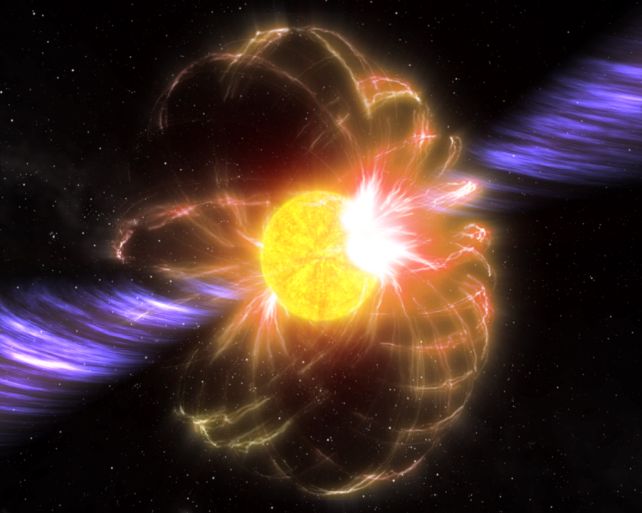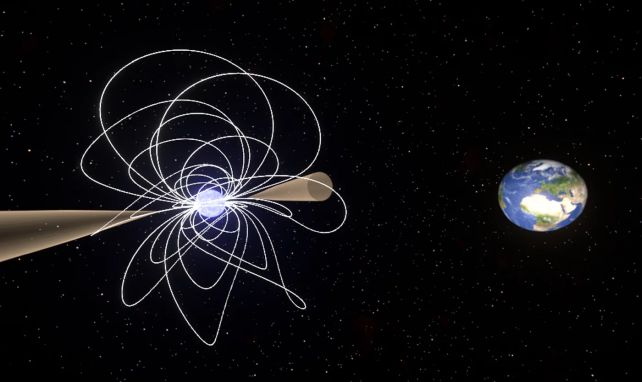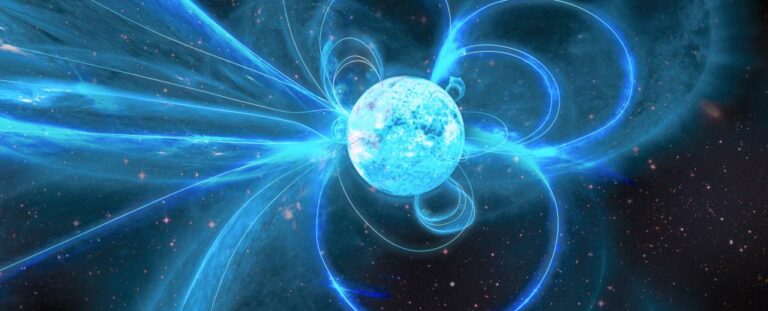A magnetic star has been roused from its 10-year slumber and is displaying highly unusual behavior.
The strangest star in the Milky Way galaxy just got weirder, i.e. it shows one of the weirdest stars.
It is a magnetar, nearby and called XTE J1810-197, and it was scientifically observed in 2003 just releasing radio waves like mad. In 2008, though, it just disappeared, and you could imagine then not seeing it for years.
Eventually, in the spring of 2018, it awakened anew. Again, there was that weird feeling about the radiation it was emitting, but again there was that weird feeling as if the radiation was being generated artificially.
Today, scientists have looked at what they received as radio waves in two different studies. And in both papers, the scientists reported that what they got was very surprising. These magnetic waves are where you have ever seen before, and the appearance of the star is stuttering.
“And in contrast to the other magnetars’ pulsar signals we’ve seen, they are emitting circularly polarized waves with unprecedented amounts of rapid switching,” says Marcus Lower of the CSIRO in Australia leading our paper, Marcus Lower of the CSIRO in Austalia, who led the first paper. “We never knew they had even seen such a car before.”
The Polarinas satellite`s observations have confirmed the theory we had that we can expect some level of variations in the extent of the polarization of the remnant`s outburst. Therefore, according to Gregory Desvignes, Team leader at the MPGF in Germany, we should not be surprised if we might witness some similar level of changes in the magnetar`s emission.
“However our anticipation was once opposite – we did not succeed in understanding how to apply the theory of the star to such variations since the obtained deviations match exactly the phenomena that would be caused by the wobbling of the star.”

Stars are marvelous, frankly magnetic but magnetars are weirdly strange. They are a family of the youngest neutron stars that—themselves—were the collapsed cores of the deceased massive stars which have got rid of most of the material during a colossal supernova explosion. With no supporting material larger than the core mass, the core collapses under the pull of gravity. This collapse is followed by extreme compression. The result is a dense ball, just 20 kilometers (12 miles) across in diameter, with a mass of 2.3 times that of our Sun.
Then, such stars achieve an incredibly high value of having a super magnetic field that is almost unbelievable before they are collapsed further within the next step that this process leads. They are like the most magnetic things in the universe, with a magnetic field a thousand times more powerful than a normal neutron star’s one, and having a number a billion times bigger than the magnitude of Earth’s field.
And, you know, that is indeed what makes them act weird. As a case in point, the scientists suppose that the sailing of magnetic field lines set against the wave of the gravity of the magnetar causes the latter to produce the giant earthquakes once in a while radiating radio waves we refer to as fast radio bursts.
In short, one of the main reasons that XTE J1810-197 is an outlier is that it is a magnetar, which already sets it apart. Nevertheless, the repeated outbreaks of the system are also worth considering. What is new about recent activity is that it is unseen in view of past – which in fact it could give to us clearer insight about these mysterious stars.
Lower, Desvignes and other researchers have taken a look at the light reflected by the star through the spectrograph, which shows that the light has polarized components. Here, the revolution of the light propagation that we see the light in a way that the orientation is a preferred direction. The polarization of magnetar light is typical, as coincident solar rotations necessitate passing magnetar light through this powerful magnetic field.
The light from the magnetars can usually be detected as only linear polarized light and has a very low amount of circularly polarized light that travels in a circular and spiral taken altogether Helmholtz pattern. In addition to XTE J1810-197, the optical polarization data for which had been studied by Lower and his colleagues, the researchers detected incredibly high levels of the circularly polarized radiation.
Such a process maybe occurs as the light passes through a ‘soup’ that’s thick and extremely hot which is the result when magnetic field of the neutron star is super-heated. It is true that XTE J1810-197 acts differently than what is described in the theory, but the scientists have some ideas on the way that might be changed about it.
“Our data indicates that there is super heating plasma above to the north pole (or the south one) where to magnetar’s magnetic field is acting like a polarizing filter,” Lower says. ”Exploration about how the plasma is doing this would be the next big research subject.”

On the other hand, as Desvignes was doing, they discovered that the polarization was the product of the change of the dipole magnetar reference’s Earth direction. In other words, it could be seen for many hours, because it appeared that every time it seemed to be wobbling, or precessing, like a spinning top. But this got surprising, too: over the coming period, the precession went on decreasing greatly, finally bringing the whole process to the point of completion.
The scientists are under the impression that the surface of the star is lying in fragments, as a consequence. It may cause the mission to rotate tine times and eject hot plasma from its magnetic field. Nevertheless, if the scenario were different and precessing magnetars are also responsible to the bursts of the fast radio signals, which are sometimes observed by us, then we may push aside the theory proposing that the precessing magnetars emit the rare, detected fast radio bursts.
While the behavior could present a lot of brand new facts associated with most violent objects of the Universe, it will also tell something about the intricate nuances of specific mysterious objects.
“Damped precession of magnetars would help us to shed light on what matters are like inside neutron stars and hence into the matter underlies our fundamental understanding.” Lijing Shao, an astrophysicist at Peking University says that.
Our curious astronauts are just going to need to stay put to see what these annoying dead stars come up with next.
The two papers have been published in Nature Astronomy. They can be found here and here.
Do not forget to share your opinion with us to provide you with the best posts !





0 Comments